Principles of Business Communication and Information: A Report
VerifiedAdded on 2022/08/20
|18
|4705
|11
Report
AI Summary
This report comprehensively examines the principles of business communication and information, covering four key areas. AC1 delves into the importance of negotiation, exploring different approaches, features, and tactics. AC2 focuses on presentations, including various types, resources, methods, best practices for delivery, and feedback collection. AC3 analyzes bespoke documents, discussing their characteristics, creation factors, legal requirements, and techniques for approval. Finally, AC4 investigates information system development, examining its stages, benefits, limitations, and legal considerations. The report draws on diverse research to provide a thorough understanding of these critical business communication elements.
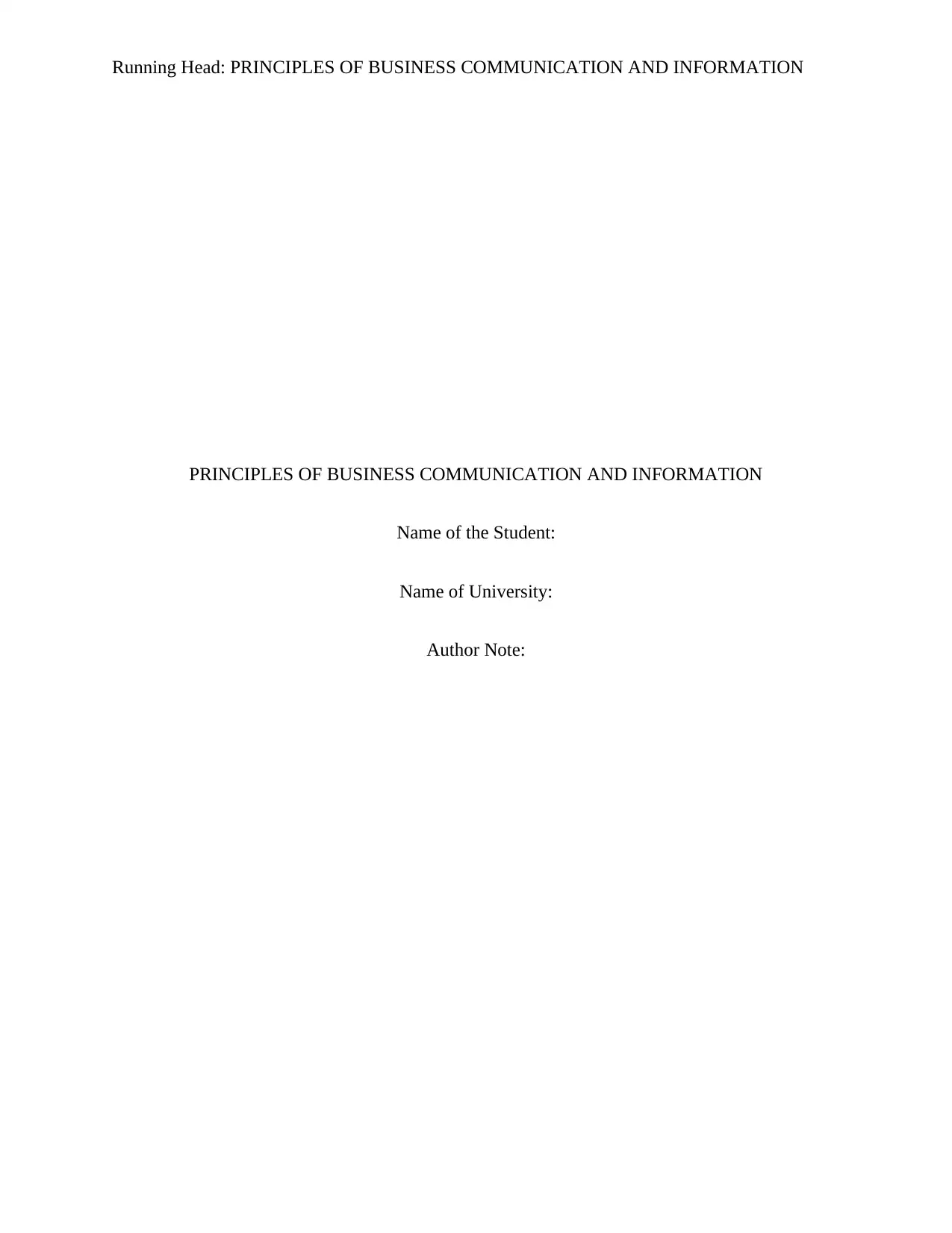
Running Head: PRINCIPLES OF BUSINESS COMMUNICATION AND INFORMATION
PRINCIPLES OF BUSINESS COMMUNICATION AND INFORMATION
Name of the Student:
Name of University:
Author Note:
PRINCIPLES OF BUSINESS COMMUNICATION AND INFORMATION
Name of the Student:
Name of University:
Author Note:
Paraphrase This Document
Need a fresh take? Get an instant paraphrase of this document with our AI Paraphraser
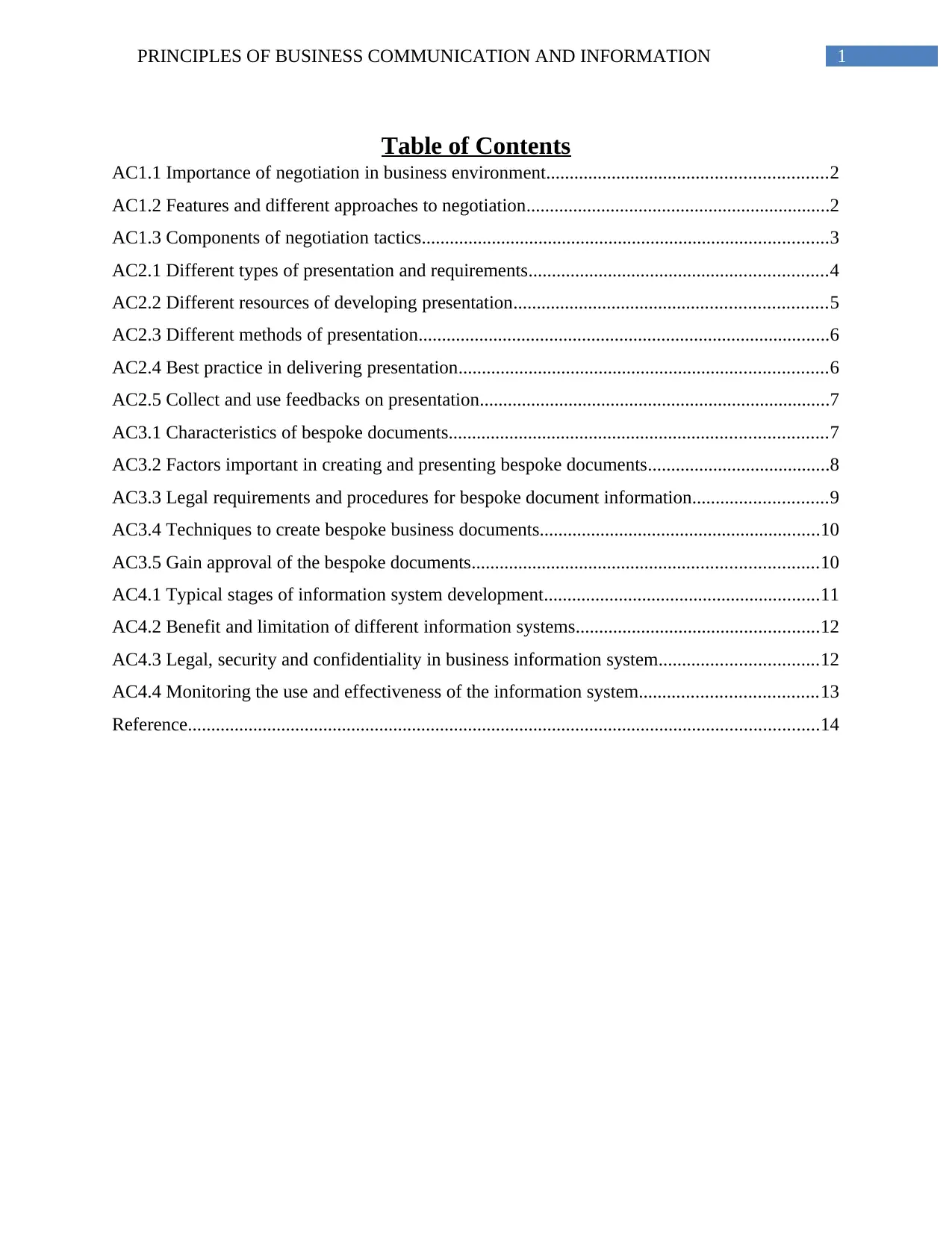
1PRINCIPLES OF BUSINESS COMMUNICATION AND INFORMATION
Table of Contents
AC1.1 Importance of negotiation in business environment............................................................2
AC1.2 Features and different approaches to negotiation.................................................................2
AC1.3 Components of negotiation tactics.......................................................................................3
AC2.1 Different types of presentation and requirements................................................................4
AC2.2 Different resources of developing presentation...................................................................5
AC2.3 Different methods of presentation........................................................................................6
AC2.4 Best practice in delivering presentation...............................................................................6
AC2.5 Collect and use feedbacks on presentation...........................................................................7
AC3.1 Characteristics of bespoke documents.................................................................................7
AC3.2 Factors important in creating and presenting bespoke documents.......................................8
AC3.3 Legal requirements and procedures for bespoke document information.............................9
AC3.4 Techniques to create bespoke business documents............................................................10
AC3.5 Gain approval of the bespoke documents..........................................................................10
AC4.1 Typical stages of information system development...........................................................11
AC4.2 Benefit and limitation of different information systems....................................................12
AC4.3 Legal, security and confidentiality in business information system..................................12
AC4.4 Monitoring the use and effectiveness of the information system......................................13
Reference.......................................................................................................................................14
Table of Contents
AC1.1 Importance of negotiation in business environment............................................................2
AC1.2 Features and different approaches to negotiation.................................................................2
AC1.3 Components of negotiation tactics.......................................................................................3
AC2.1 Different types of presentation and requirements................................................................4
AC2.2 Different resources of developing presentation...................................................................5
AC2.3 Different methods of presentation........................................................................................6
AC2.4 Best practice in delivering presentation...............................................................................6
AC2.5 Collect and use feedbacks on presentation...........................................................................7
AC3.1 Characteristics of bespoke documents.................................................................................7
AC3.2 Factors important in creating and presenting bespoke documents.......................................8
AC3.3 Legal requirements and procedures for bespoke document information.............................9
AC3.4 Techniques to create bespoke business documents............................................................10
AC3.5 Gain approval of the bespoke documents..........................................................................10
AC4.1 Typical stages of information system development...........................................................11
AC4.2 Benefit and limitation of different information systems....................................................12
AC4.3 Legal, security and confidentiality in business information system..................................12
AC4.4 Monitoring the use and effectiveness of the information system......................................13
Reference.......................................................................................................................................14
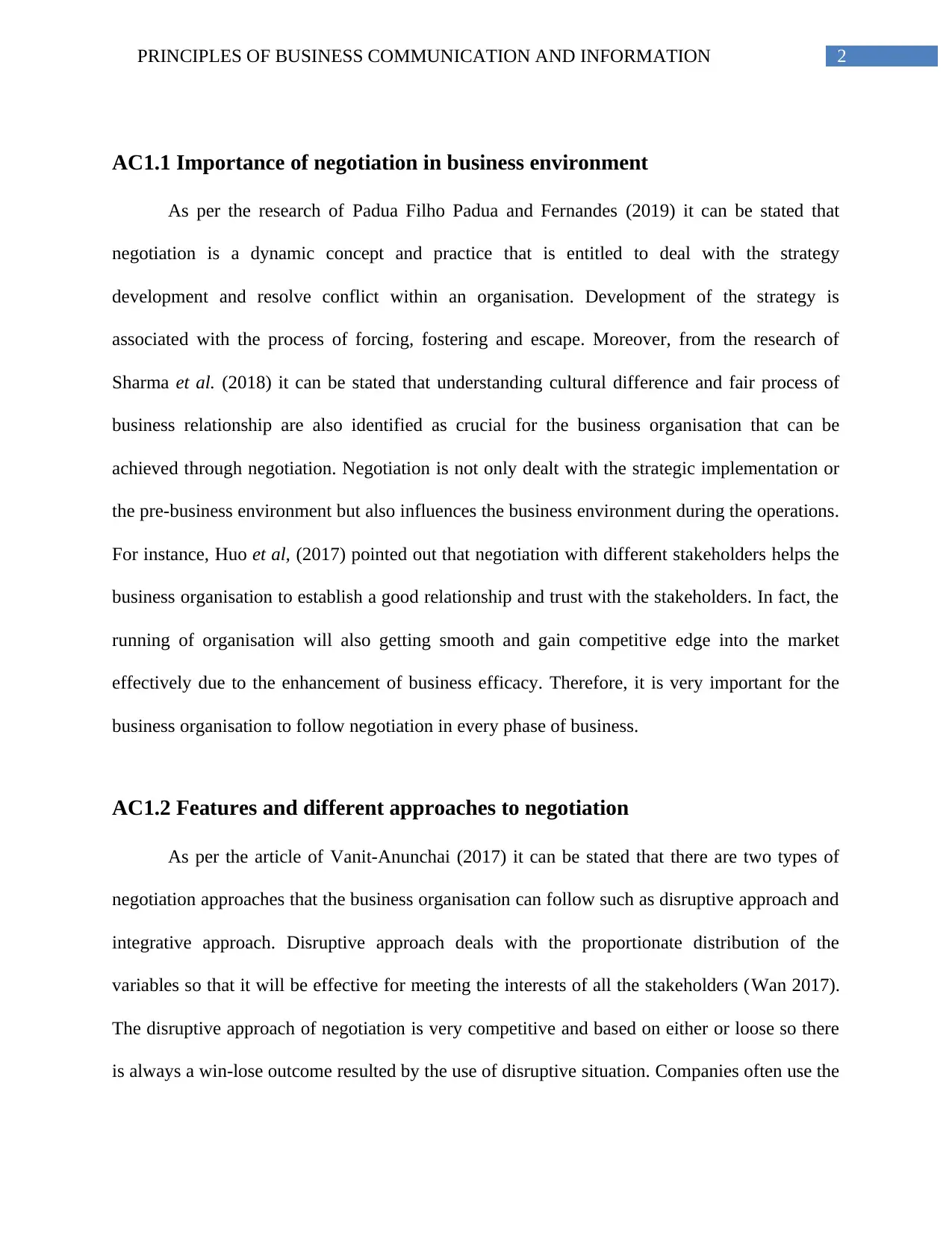
2PRINCIPLES OF BUSINESS COMMUNICATION AND INFORMATION
AC1.1 Importance of negotiation in business environment
As per the research of Padua Filho Padua and Fernandes (2019) it can be stated that
negotiation is a dynamic concept and practice that is entitled to deal with the strategy
development and resolve conflict within an organisation. Development of the strategy is
associated with the process of forcing, fostering and escape. Moreover, from the research of
Sharma et al. (2018) it can be stated that understanding cultural difference and fair process of
business relationship are also identified as crucial for the business organisation that can be
achieved through negotiation. Negotiation is not only dealt with the strategic implementation or
the pre-business environment but also influences the business environment during the operations.
For instance, Huo et al, (2017) pointed out that negotiation with different stakeholders helps the
business organisation to establish a good relationship and trust with the stakeholders. In fact, the
running of organisation will also getting smooth and gain competitive edge into the market
effectively due to the enhancement of business efficacy. Therefore, it is very important for the
business organisation to follow negotiation in every phase of business.
AC1.2 Features and different approaches to negotiation
As per the article of Vanit-Anunchai (2017) it can be stated that there are two types of
negotiation approaches that the business organisation can follow such as disruptive approach and
integrative approach. Disruptive approach deals with the proportionate distribution of the
variables so that it will be effective for meeting the interests of all the stakeholders (Wan 2017).
The disruptive approach of negotiation is very competitive and based on either or loose so there
is always a win-lose outcome resulted by the use of disruptive situation. Companies often use the
AC1.1 Importance of negotiation in business environment
As per the research of Padua Filho Padua and Fernandes (2019) it can be stated that
negotiation is a dynamic concept and practice that is entitled to deal with the strategy
development and resolve conflict within an organisation. Development of the strategy is
associated with the process of forcing, fostering and escape. Moreover, from the research of
Sharma et al. (2018) it can be stated that understanding cultural difference and fair process of
business relationship are also identified as crucial for the business organisation that can be
achieved through negotiation. Negotiation is not only dealt with the strategic implementation or
the pre-business environment but also influences the business environment during the operations.
For instance, Huo et al, (2017) pointed out that negotiation with different stakeholders helps the
business organisation to establish a good relationship and trust with the stakeholders. In fact, the
running of organisation will also getting smooth and gain competitive edge into the market
effectively due to the enhancement of business efficacy. Therefore, it is very important for the
business organisation to follow negotiation in every phase of business.
AC1.2 Features and different approaches to negotiation
As per the article of Vanit-Anunchai (2017) it can be stated that there are two types of
negotiation approaches that the business organisation can follow such as disruptive approach and
integrative approach. Disruptive approach deals with the proportionate distribution of the
variables so that it will be effective for meeting the interests of all the stakeholders (Wan 2017).
The disruptive approach of negotiation is very competitive and based on either or loose so there
is always a win-lose outcome resulted by the use of disruptive situation. Companies often use the
⊘ This is a preview!⊘
Do you want full access?
Subscribe today to unlock all pages.

Trusted by 1+ million students worldwide
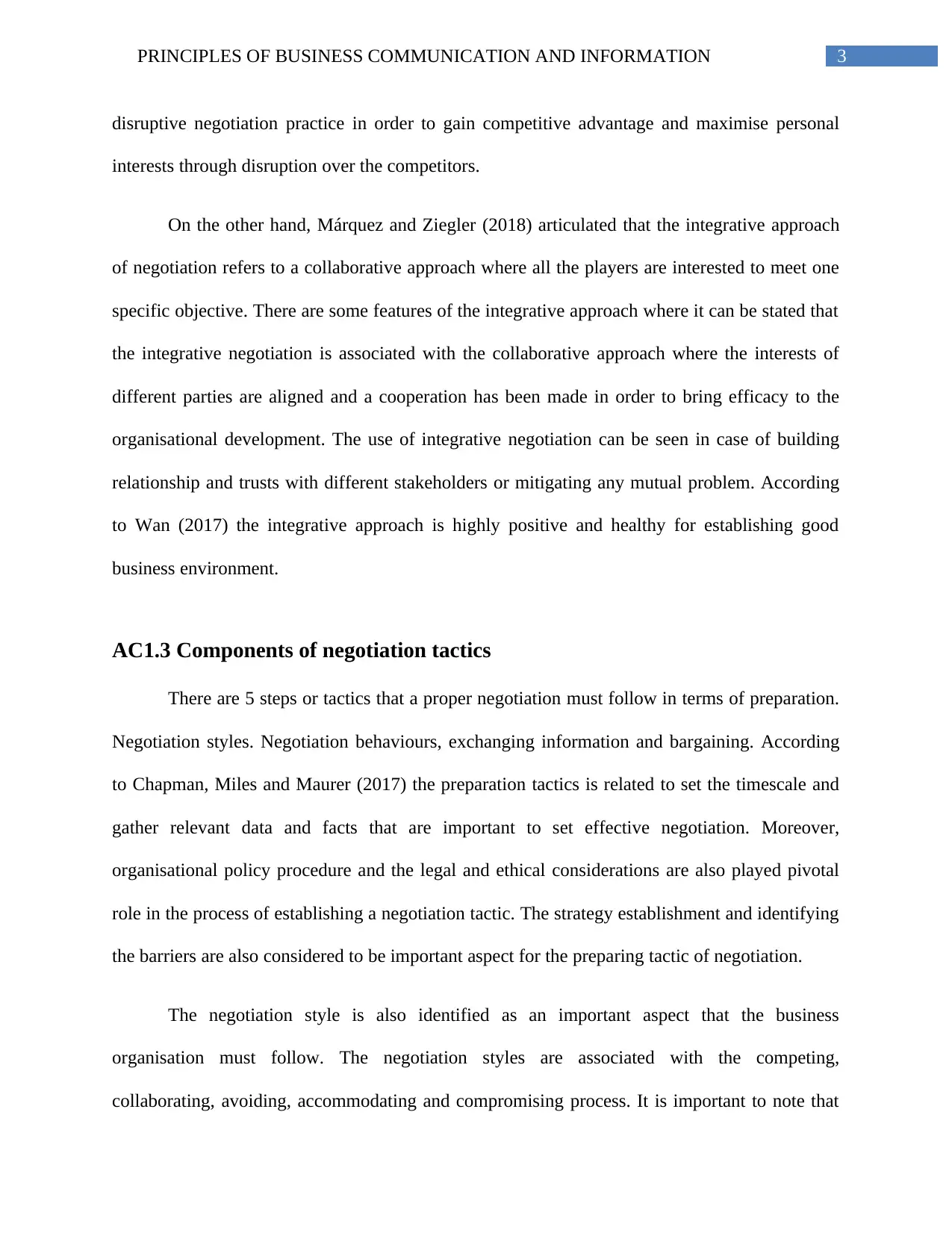
3PRINCIPLES OF BUSINESS COMMUNICATION AND INFORMATION
disruptive negotiation practice in order to gain competitive advantage and maximise personal
interests through disruption over the competitors.
On the other hand, Márquez and Ziegler (2018) articulated that the integrative approach
of negotiation refers to a collaborative approach where all the players are interested to meet one
specific objective. There are some features of the integrative approach where it can be stated that
the integrative negotiation is associated with the collaborative approach where the interests of
different parties are aligned and a cooperation has been made in order to bring efficacy to the
organisational development. The use of integrative negotiation can be seen in case of building
relationship and trusts with different stakeholders or mitigating any mutual problem. According
to Wan (2017) the integrative approach is highly positive and healthy for establishing good
business environment.
AC1.3 Components of negotiation tactics
There are 5 steps or tactics that a proper negotiation must follow in terms of preparation.
Negotiation styles. Negotiation behaviours, exchanging information and bargaining. According
to Chapman, Miles and Maurer (2017) the preparation tactics is related to set the timescale and
gather relevant data and facts that are important to set effective negotiation. Moreover,
organisational policy procedure and the legal and ethical considerations are also played pivotal
role in the process of establishing a negotiation tactic. The strategy establishment and identifying
the barriers are also considered to be important aspect for the preparing tactic of negotiation.
The negotiation style is also identified as an important aspect that the business
organisation must follow. The negotiation styles are associated with the competing,
collaborating, avoiding, accommodating and compromising process. It is important to note that
disruptive negotiation practice in order to gain competitive advantage and maximise personal
interests through disruption over the competitors.
On the other hand, Márquez and Ziegler (2018) articulated that the integrative approach
of negotiation refers to a collaborative approach where all the players are interested to meet one
specific objective. There are some features of the integrative approach where it can be stated that
the integrative negotiation is associated with the collaborative approach where the interests of
different parties are aligned and a cooperation has been made in order to bring efficacy to the
organisational development. The use of integrative negotiation can be seen in case of building
relationship and trusts with different stakeholders or mitigating any mutual problem. According
to Wan (2017) the integrative approach is highly positive and healthy for establishing good
business environment.
AC1.3 Components of negotiation tactics
There are 5 steps or tactics that a proper negotiation must follow in terms of preparation.
Negotiation styles. Negotiation behaviours, exchanging information and bargaining. According
to Chapman, Miles and Maurer (2017) the preparation tactics is related to set the timescale and
gather relevant data and facts that are important to set effective negotiation. Moreover,
organisational policy procedure and the legal and ethical considerations are also played pivotal
role in the process of establishing a negotiation tactic. The strategy establishment and identifying
the barriers are also considered to be important aspect for the preparing tactic of negotiation.
The negotiation style is also identified as an important aspect that the business
organisation must follow. The negotiation styles are associated with the competing,
collaborating, avoiding, accommodating and compromising process. It is important to note that
Paraphrase This Document
Need a fresh take? Get an instant paraphrase of this document with our AI Paraphraser
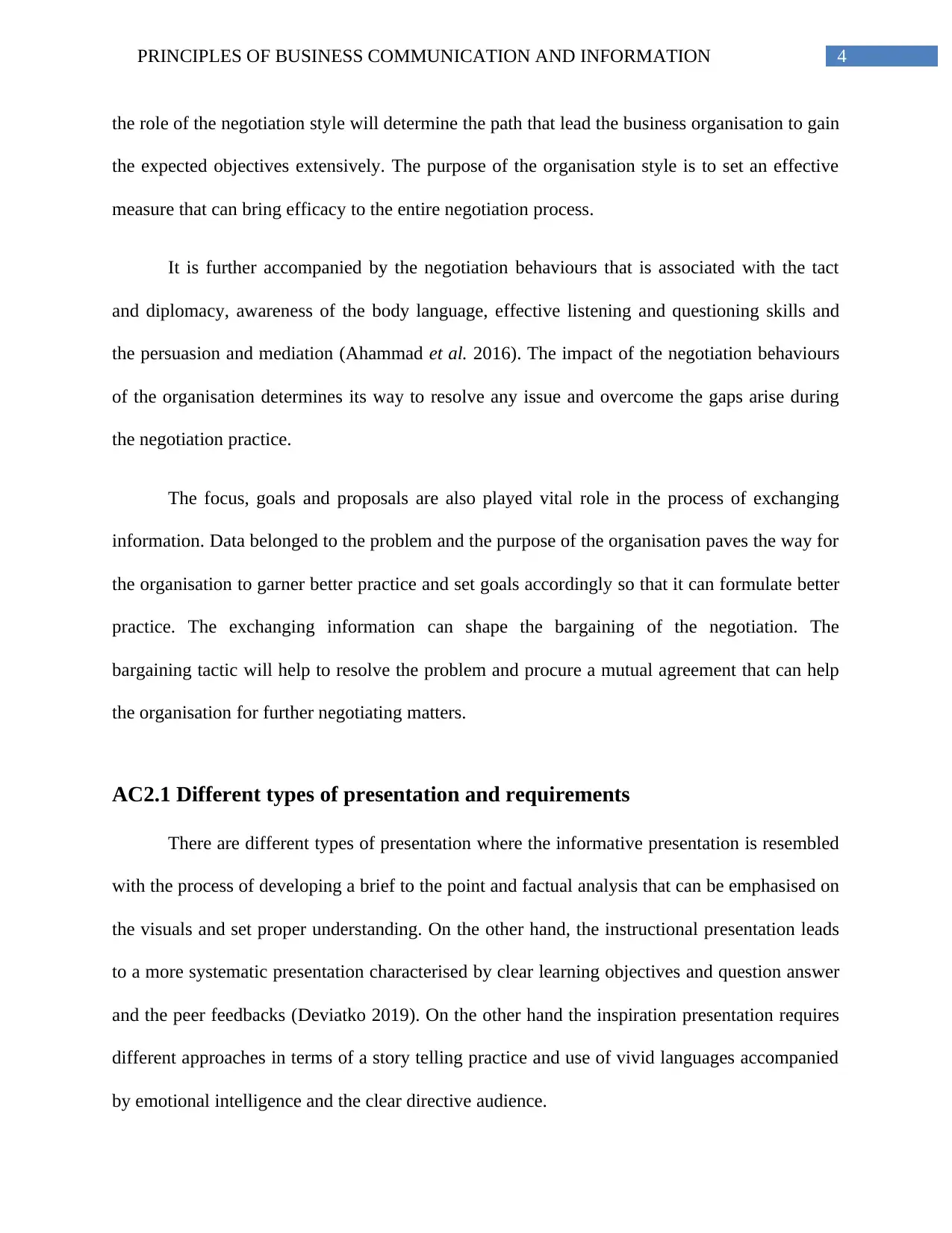
4PRINCIPLES OF BUSINESS COMMUNICATION AND INFORMATION
the role of the negotiation style will determine the path that lead the business organisation to gain
the expected objectives extensively. The purpose of the organisation style is to set an effective
measure that can bring efficacy to the entire negotiation process.
It is further accompanied by the negotiation behaviours that is associated with the tact
and diplomacy, awareness of the body language, effective listening and questioning skills and
the persuasion and mediation (Ahammad et al. 2016). The impact of the negotiation behaviours
of the organisation determines its way to resolve any issue and overcome the gaps arise during
the negotiation practice.
The focus, goals and proposals are also played vital role in the process of exchanging
information. Data belonged to the problem and the purpose of the organisation paves the way for
the organisation to garner better practice and set goals accordingly so that it can formulate better
practice. The exchanging information can shape the bargaining of the negotiation. The
bargaining tactic will help to resolve the problem and procure a mutual agreement that can help
the organisation for further negotiating matters.
AC2.1 Different types of presentation and requirements
There are different types of presentation where the informative presentation is resembled
with the process of developing a brief to the point and factual analysis that can be emphasised on
the visuals and set proper understanding. On the other hand, the instructional presentation leads
to a more systematic presentation characterised by clear learning objectives and question answer
and the peer feedbacks (Deviatko 2019). On the other hand the inspiration presentation requires
different approaches in terms of a story telling practice and use of vivid languages accompanied
by emotional intelligence and the clear directive audience.
the role of the negotiation style will determine the path that lead the business organisation to gain
the expected objectives extensively. The purpose of the organisation style is to set an effective
measure that can bring efficacy to the entire negotiation process.
It is further accompanied by the negotiation behaviours that is associated with the tact
and diplomacy, awareness of the body language, effective listening and questioning skills and
the persuasion and mediation (Ahammad et al. 2016). The impact of the negotiation behaviours
of the organisation determines its way to resolve any issue and overcome the gaps arise during
the negotiation practice.
The focus, goals and proposals are also played vital role in the process of exchanging
information. Data belonged to the problem and the purpose of the organisation paves the way for
the organisation to garner better practice and set goals accordingly so that it can formulate better
practice. The exchanging information can shape the bargaining of the negotiation. The
bargaining tactic will help to resolve the problem and procure a mutual agreement that can help
the organisation for further negotiating matters.
AC2.1 Different types of presentation and requirements
There are different types of presentation where the informative presentation is resembled
with the process of developing a brief to the point and factual analysis that can be emphasised on
the visuals and set proper understanding. On the other hand, the instructional presentation leads
to a more systematic presentation characterised by clear learning objectives and question answer
and the peer feedbacks (Deviatko 2019). On the other hand the inspiration presentation requires
different approaches in terms of a story telling practice and use of vivid languages accompanied
by emotional intelligence and the clear directive audience.
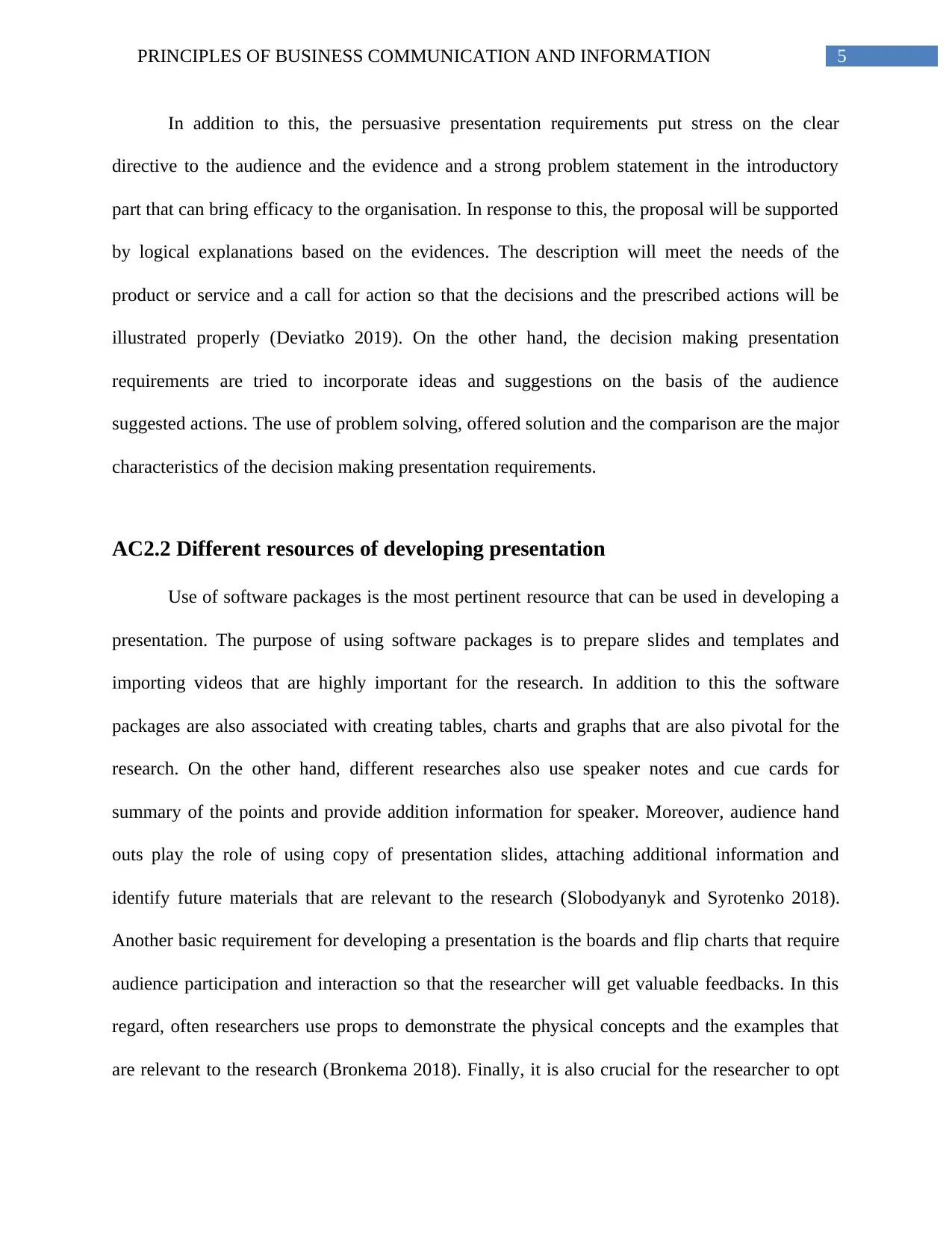
5PRINCIPLES OF BUSINESS COMMUNICATION AND INFORMATION
In addition to this, the persuasive presentation requirements put stress on the clear
directive to the audience and the evidence and a strong problem statement in the introductory
part that can bring efficacy to the organisation. In response to this, the proposal will be supported
by logical explanations based on the evidences. The description will meet the needs of the
product or service and a call for action so that the decisions and the prescribed actions will be
illustrated properly (Deviatko 2019). On the other hand, the decision making presentation
requirements are tried to incorporate ideas and suggestions on the basis of the audience
suggested actions. The use of problem solving, offered solution and the comparison are the major
characteristics of the decision making presentation requirements.
AC2.2 Different resources of developing presentation
Use of software packages is the most pertinent resource that can be used in developing a
presentation. The purpose of using software packages is to prepare slides and templates and
importing videos that are highly important for the research. In addition to this the software
packages are also associated with creating tables, charts and graphs that are also pivotal for the
research. On the other hand, different researches also use speaker notes and cue cards for
summary of the points and provide addition information for speaker. Moreover, audience hand
outs play the role of using copy of presentation slides, attaching additional information and
identify future materials that are relevant to the research (Slobodyanyk and Syrotenko 2018).
Another basic requirement for developing a presentation is the boards and flip charts that require
audience participation and interaction so that the researcher will get valuable feedbacks. In this
regard, often researchers use props to demonstrate the physical concepts and the examples that
are relevant to the research (Bronkema 2018). Finally, it is also crucial for the researcher to opt
In addition to this, the persuasive presentation requirements put stress on the clear
directive to the audience and the evidence and a strong problem statement in the introductory
part that can bring efficacy to the organisation. In response to this, the proposal will be supported
by logical explanations based on the evidences. The description will meet the needs of the
product or service and a call for action so that the decisions and the prescribed actions will be
illustrated properly (Deviatko 2019). On the other hand, the decision making presentation
requirements are tried to incorporate ideas and suggestions on the basis of the audience
suggested actions. The use of problem solving, offered solution and the comparison are the major
characteristics of the decision making presentation requirements.
AC2.2 Different resources of developing presentation
Use of software packages is the most pertinent resource that can be used in developing a
presentation. The purpose of using software packages is to prepare slides and templates and
importing videos that are highly important for the research. In addition to this the software
packages are also associated with creating tables, charts and graphs that are also pivotal for the
research. On the other hand, different researches also use speaker notes and cue cards for
summary of the points and provide addition information for speaker. Moreover, audience hand
outs play the role of using copy of presentation slides, attaching additional information and
identify future materials that are relevant to the research (Slobodyanyk and Syrotenko 2018).
Another basic requirement for developing a presentation is the boards and flip charts that require
audience participation and interaction so that the researcher will get valuable feedbacks. In this
regard, often researchers use props to demonstrate the physical concepts and the examples that
are relevant to the research (Bronkema 2018). Finally, it is also crucial for the researcher to opt
⊘ This is a preview!⊘
Do you want full access?
Subscribe today to unlock all pages.

Trusted by 1+ million students worldwide
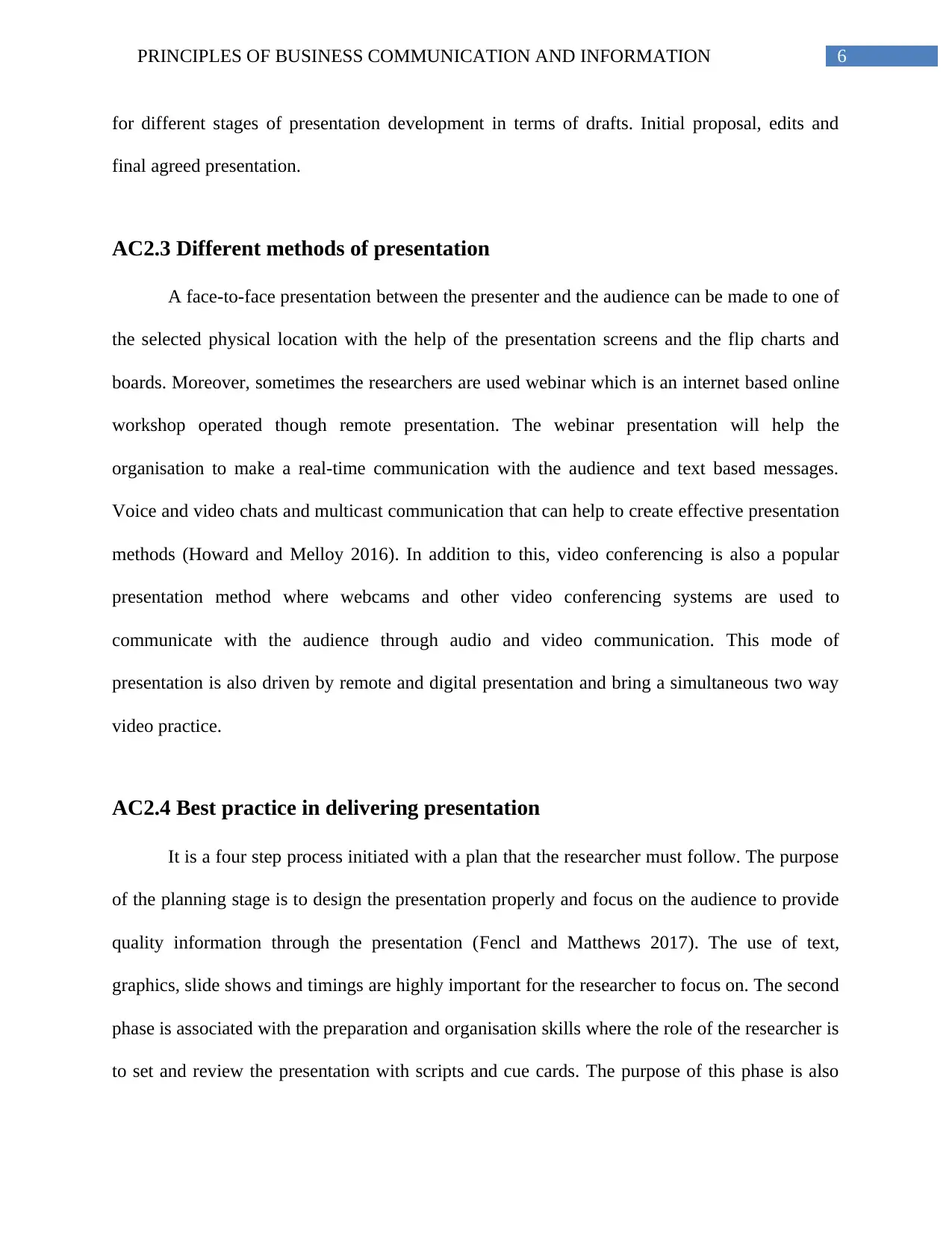
6PRINCIPLES OF BUSINESS COMMUNICATION AND INFORMATION
for different stages of presentation development in terms of drafts. Initial proposal, edits and
final agreed presentation.
AC2.3 Different methods of presentation
A face-to-face presentation between the presenter and the audience can be made to one of
the selected physical location with the help of the presentation screens and the flip charts and
boards. Moreover, sometimes the researchers are used webinar which is an internet based online
workshop operated though remote presentation. The webinar presentation will help the
organisation to make a real-time communication with the audience and text based messages.
Voice and video chats and multicast communication that can help to create effective presentation
methods (Howard and Melloy 2016). In addition to this, video conferencing is also a popular
presentation method where webcams and other video conferencing systems are used to
communicate with the audience through audio and video communication. This mode of
presentation is also driven by remote and digital presentation and bring a simultaneous two way
video practice.
AC2.4 Best practice in delivering presentation
It is a four step process initiated with a plan that the researcher must follow. The purpose
of the planning stage is to design the presentation properly and focus on the audience to provide
quality information through the presentation (Fencl and Matthews 2017). The use of text,
graphics, slide shows and timings are highly important for the researcher to focus on. The second
phase is associated with the preparation and organisation skills where the role of the researcher is
to set and review the presentation with scripts and cue cards. The purpose of this phase is also
for different stages of presentation development in terms of drafts. Initial proposal, edits and
final agreed presentation.
AC2.3 Different methods of presentation
A face-to-face presentation between the presenter and the audience can be made to one of
the selected physical location with the help of the presentation screens and the flip charts and
boards. Moreover, sometimes the researchers are used webinar which is an internet based online
workshop operated though remote presentation. The webinar presentation will help the
organisation to make a real-time communication with the audience and text based messages.
Voice and video chats and multicast communication that can help to create effective presentation
methods (Howard and Melloy 2016). In addition to this, video conferencing is also a popular
presentation method where webcams and other video conferencing systems are used to
communicate with the audience through audio and video communication. This mode of
presentation is also driven by remote and digital presentation and bring a simultaneous two way
video practice.
AC2.4 Best practice in delivering presentation
It is a four step process initiated with a plan that the researcher must follow. The purpose
of the planning stage is to design the presentation properly and focus on the audience to provide
quality information through the presentation (Fencl and Matthews 2017). The use of text,
graphics, slide shows and timings are highly important for the researcher to focus on. The second
phase is associated with the preparation and organisation skills where the role of the researcher is
to set and review the presentation with scripts and cue cards. The purpose of this phase is also
Paraphrase This Document
Need a fresh take? Get an instant paraphrase of this document with our AI Paraphraser
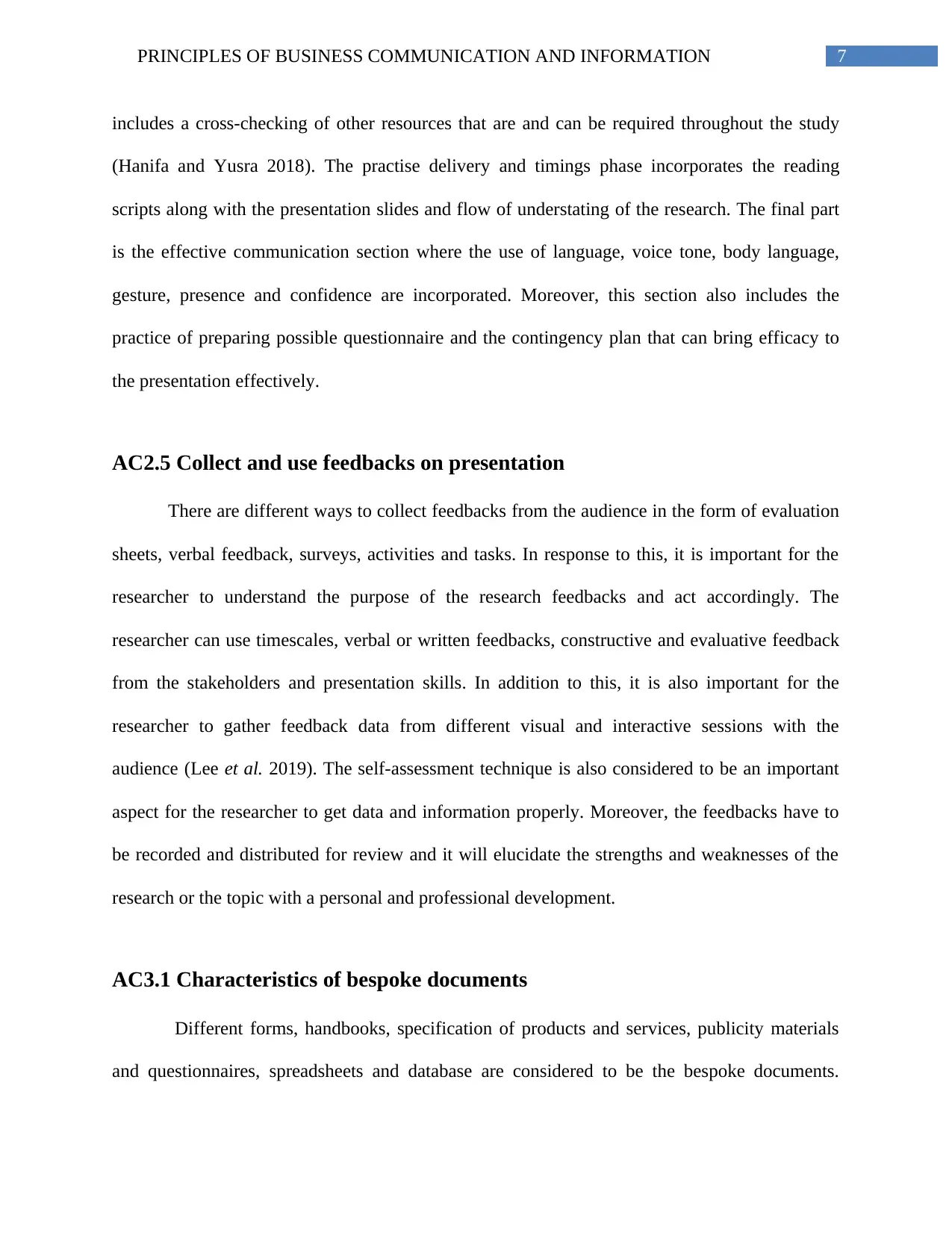
7PRINCIPLES OF BUSINESS COMMUNICATION AND INFORMATION
includes a cross-checking of other resources that are and can be required throughout the study
(Hanifa and Yusra 2018). The practise delivery and timings phase incorporates the reading
scripts along with the presentation slides and flow of understating of the research. The final part
is the effective communication section where the use of language, voice tone, body language,
gesture, presence and confidence are incorporated. Moreover, this section also includes the
practice of preparing possible questionnaire and the contingency plan that can bring efficacy to
the presentation effectively.
AC2.5 Collect and use feedbacks on presentation
There are different ways to collect feedbacks from the audience in the form of evaluation
sheets, verbal feedback, surveys, activities and tasks. In response to this, it is important for the
researcher to understand the purpose of the research feedbacks and act accordingly. The
researcher can use timescales, verbal or written feedbacks, constructive and evaluative feedback
from the stakeholders and presentation skills. In addition to this, it is also important for the
researcher to gather feedback data from different visual and interactive sessions with the
audience (Lee et al. 2019). The self-assessment technique is also considered to be an important
aspect for the researcher to get data and information properly. Moreover, the feedbacks have to
be recorded and distributed for review and it will elucidate the strengths and weaknesses of the
research or the topic with a personal and professional development.
AC3.1 Characteristics of bespoke documents
Different forms, handbooks, specification of products and services, publicity materials
and questionnaires, spreadsheets and database are considered to be the bespoke documents.
includes a cross-checking of other resources that are and can be required throughout the study
(Hanifa and Yusra 2018). The practise delivery and timings phase incorporates the reading
scripts along with the presentation slides and flow of understating of the research. The final part
is the effective communication section where the use of language, voice tone, body language,
gesture, presence and confidence are incorporated. Moreover, this section also includes the
practice of preparing possible questionnaire and the contingency plan that can bring efficacy to
the presentation effectively.
AC2.5 Collect and use feedbacks on presentation
There are different ways to collect feedbacks from the audience in the form of evaluation
sheets, verbal feedback, surveys, activities and tasks. In response to this, it is important for the
researcher to understand the purpose of the research feedbacks and act accordingly. The
researcher can use timescales, verbal or written feedbacks, constructive and evaluative feedback
from the stakeholders and presentation skills. In addition to this, it is also important for the
researcher to gather feedback data from different visual and interactive sessions with the
audience (Lee et al. 2019). The self-assessment technique is also considered to be an important
aspect for the researcher to get data and information properly. Moreover, the feedbacks have to
be recorded and distributed for review and it will elucidate the strengths and weaknesses of the
research or the topic with a personal and professional development.
AC3.1 Characteristics of bespoke documents
Different forms, handbooks, specification of products and services, publicity materials
and questionnaires, spreadsheets and database are considered to be the bespoke documents.
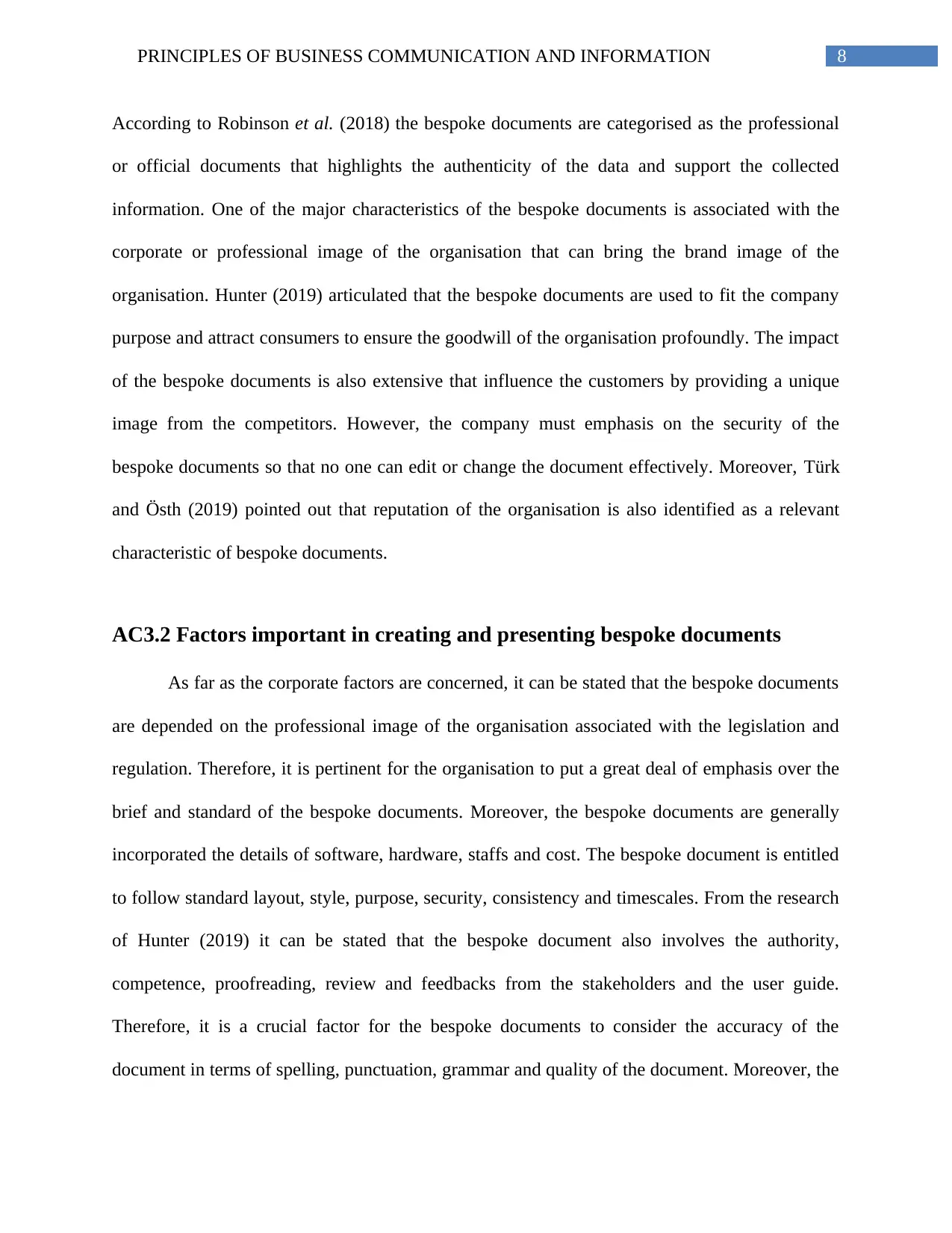
8PRINCIPLES OF BUSINESS COMMUNICATION AND INFORMATION
According to Robinson et al. (2018) the bespoke documents are categorised as the professional
or official documents that highlights the authenticity of the data and support the collected
information. One of the major characteristics of the bespoke documents is associated with the
corporate or professional image of the organisation that can bring the brand image of the
organisation. Hunter (2019) articulated that the bespoke documents are used to fit the company
purpose and attract consumers to ensure the goodwill of the organisation profoundly. The impact
of the bespoke documents is also extensive that influence the customers by providing a unique
image from the competitors. However, the company must emphasis on the security of the
bespoke documents so that no one can edit or change the document effectively. Moreover, Türk
and Östh (2019) pointed out that reputation of the organisation is also identified as a relevant
characteristic of bespoke documents.
AC3.2 Factors important in creating and presenting bespoke documents
As far as the corporate factors are concerned, it can be stated that the bespoke documents
are depended on the professional image of the organisation associated with the legislation and
regulation. Therefore, it is pertinent for the organisation to put a great deal of emphasis over the
brief and standard of the bespoke documents. Moreover, the bespoke documents are generally
incorporated the details of software, hardware, staffs and cost. The bespoke document is entitled
to follow standard layout, style, purpose, security, consistency and timescales. From the research
of Hunter (2019) it can be stated that the bespoke document also involves the authority,
competence, proofreading, review and feedbacks from the stakeholders and the user guide.
Therefore, it is a crucial factor for the bespoke documents to consider the accuracy of the
document in terms of spelling, punctuation, grammar and quality of the document. Moreover, the
According to Robinson et al. (2018) the bespoke documents are categorised as the professional
or official documents that highlights the authenticity of the data and support the collected
information. One of the major characteristics of the bespoke documents is associated with the
corporate or professional image of the organisation that can bring the brand image of the
organisation. Hunter (2019) articulated that the bespoke documents are used to fit the company
purpose and attract consumers to ensure the goodwill of the organisation profoundly. The impact
of the bespoke documents is also extensive that influence the customers by providing a unique
image from the competitors. However, the company must emphasis on the security of the
bespoke documents so that no one can edit or change the document effectively. Moreover, Türk
and Östh (2019) pointed out that reputation of the organisation is also identified as a relevant
characteristic of bespoke documents.
AC3.2 Factors important in creating and presenting bespoke documents
As far as the corporate factors are concerned, it can be stated that the bespoke documents
are depended on the professional image of the organisation associated with the legislation and
regulation. Therefore, it is pertinent for the organisation to put a great deal of emphasis over the
brief and standard of the bespoke documents. Moreover, the bespoke documents are generally
incorporated the details of software, hardware, staffs and cost. The bespoke document is entitled
to follow standard layout, style, purpose, security, consistency and timescales. From the research
of Hunter (2019) it can be stated that the bespoke document also involves the authority,
competence, proofreading, review and feedbacks from the stakeholders and the user guide.
Therefore, it is a crucial factor for the bespoke documents to consider the accuracy of the
document in terms of spelling, punctuation, grammar and quality of the document. Moreover, the
⊘ This is a preview!⊘
Do you want full access?
Subscribe today to unlock all pages.

Trusted by 1+ million students worldwide
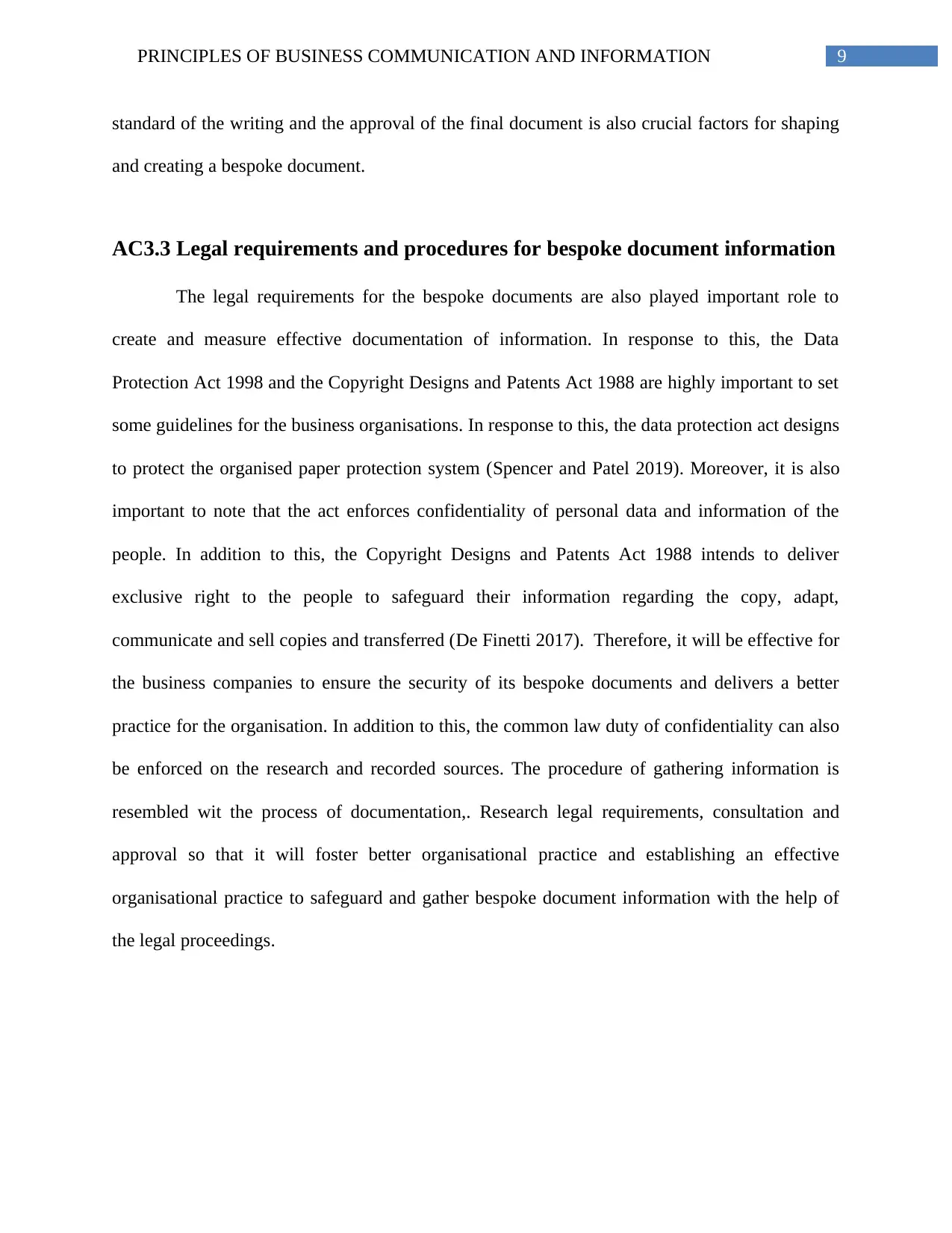
9PRINCIPLES OF BUSINESS COMMUNICATION AND INFORMATION
standard of the writing and the approval of the final document is also crucial factors for shaping
and creating a bespoke document.
AC3.3 Legal requirements and procedures for bespoke document information
The legal requirements for the bespoke documents are also played important role to
create and measure effective documentation of information. In response to this, the Data
Protection Act 1998 and the Copyright Designs and Patents Act 1988 are highly important to set
some guidelines for the business organisations. In response to this, the data protection act designs
to protect the organised paper protection system (Spencer and Patel 2019). Moreover, it is also
important to note that the act enforces confidentiality of personal data and information of the
people. In addition to this, the Copyright Designs and Patents Act 1988 intends to deliver
exclusive right to the people to safeguard their information regarding the copy, adapt,
communicate and sell copies and transferred (De Finetti 2017). Therefore, it will be effective for
the business companies to ensure the security of its bespoke documents and delivers a better
practice for the organisation. In addition to this, the common law duty of confidentiality can also
be enforced on the research and recorded sources. The procedure of gathering information is
resembled wit the process of documentation,. Research legal requirements, consultation and
approval so that it will foster better organisational practice and establishing an effective
organisational practice to safeguard and gather bespoke document information with the help of
the legal proceedings.
standard of the writing and the approval of the final document is also crucial factors for shaping
and creating a bespoke document.
AC3.3 Legal requirements and procedures for bespoke document information
The legal requirements for the bespoke documents are also played important role to
create and measure effective documentation of information. In response to this, the Data
Protection Act 1998 and the Copyright Designs and Patents Act 1988 are highly important to set
some guidelines for the business organisations. In response to this, the data protection act designs
to protect the organised paper protection system (Spencer and Patel 2019). Moreover, it is also
important to note that the act enforces confidentiality of personal data and information of the
people. In addition to this, the Copyright Designs and Patents Act 1988 intends to deliver
exclusive right to the people to safeguard their information regarding the copy, adapt,
communicate and sell copies and transferred (De Finetti 2017). Therefore, it will be effective for
the business companies to ensure the security of its bespoke documents and delivers a better
practice for the organisation. In addition to this, the common law duty of confidentiality can also
be enforced on the research and recorded sources. The procedure of gathering information is
resembled wit the process of documentation,. Research legal requirements, consultation and
approval so that it will foster better organisational practice and establishing an effective
organisational practice to safeguard and gather bespoke document information with the help of
the legal proceedings.
Paraphrase This Document
Need a fresh take? Get an instant paraphrase of this document with our AI Paraphraser
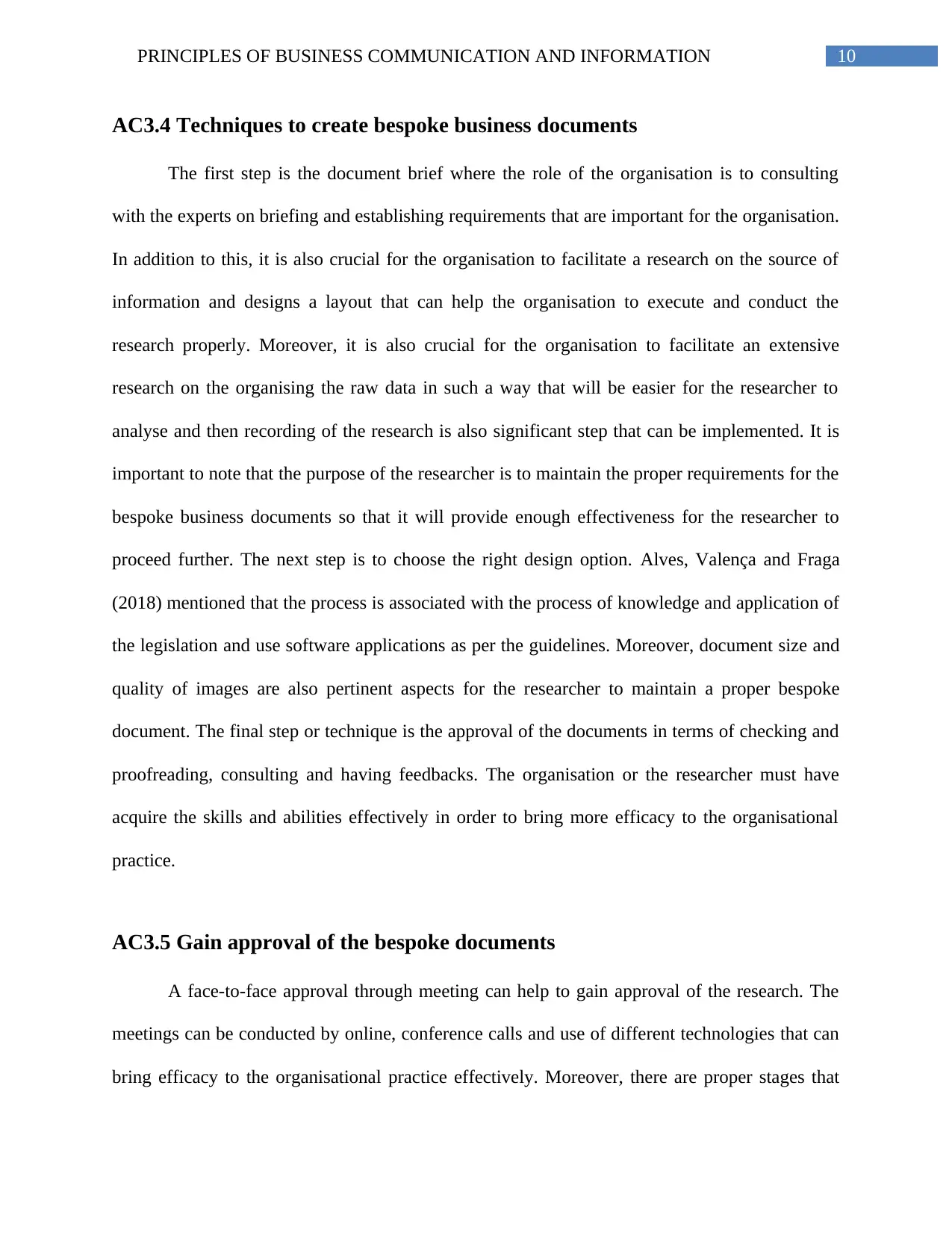
10PRINCIPLES OF BUSINESS COMMUNICATION AND INFORMATION
AC3.4 Techniques to create bespoke business documents
The first step is the document brief where the role of the organisation is to consulting
with the experts on briefing and establishing requirements that are important for the organisation.
In addition to this, it is also crucial for the organisation to facilitate a research on the source of
information and designs a layout that can help the organisation to execute and conduct the
research properly. Moreover, it is also crucial for the organisation to facilitate an extensive
research on the organising the raw data in such a way that will be easier for the researcher to
analyse and then recording of the research is also significant step that can be implemented. It is
important to note that the purpose of the researcher is to maintain the proper requirements for the
bespoke business documents so that it will provide enough effectiveness for the researcher to
proceed further. The next step is to choose the right design option. Alves, Valença and Fraga
(2018) mentioned that the process is associated with the process of knowledge and application of
the legislation and use software applications as per the guidelines. Moreover, document size and
quality of images are also pertinent aspects for the researcher to maintain a proper bespoke
document. The final step or technique is the approval of the documents in terms of checking and
proofreading, consulting and having feedbacks. The organisation or the researcher must have
acquire the skills and abilities effectively in order to bring more efficacy to the organisational
practice.
AC3.5 Gain approval of the bespoke documents
A face-to-face approval through meeting can help to gain approval of the research. The
meetings can be conducted by online, conference calls and use of different technologies that can
bring efficacy to the organisational practice effectively. Moreover, there are proper stages that
AC3.4 Techniques to create bespoke business documents
The first step is the document brief where the role of the organisation is to consulting
with the experts on briefing and establishing requirements that are important for the organisation.
In addition to this, it is also crucial for the organisation to facilitate a research on the source of
information and designs a layout that can help the organisation to execute and conduct the
research properly. Moreover, it is also crucial for the organisation to facilitate an extensive
research on the organising the raw data in such a way that will be easier for the researcher to
analyse and then recording of the research is also significant step that can be implemented. It is
important to note that the purpose of the researcher is to maintain the proper requirements for the
bespoke business documents so that it will provide enough effectiveness for the researcher to
proceed further. The next step is to choose the right design option. Alves, Valença and Fraga
(2018) mentioned that the process is associated with the process of knowledge and application of
the legislation and use software applications as per the guidelines. Moreover, document size and
quality of images are also pertinent aspects for the researcher to maintain a proper bespoke
document. The final step or technique is the approval of the documents in terms of checking and
proofreading, consulting and having feedbacks. The organisation or the researcher must have
acquire the skills and abilities effectively in order to bring more efficacy to the organisational
practice.
AC3.5 Gain approval of the bespoke documents
A face-to-face approval through meeting can help to gain approval of the research. The
meetings can be conducted by online, conference calls and use of different technologies that can
bring efficacy to the organisational practice effectively. Moreover, there are proper stages that
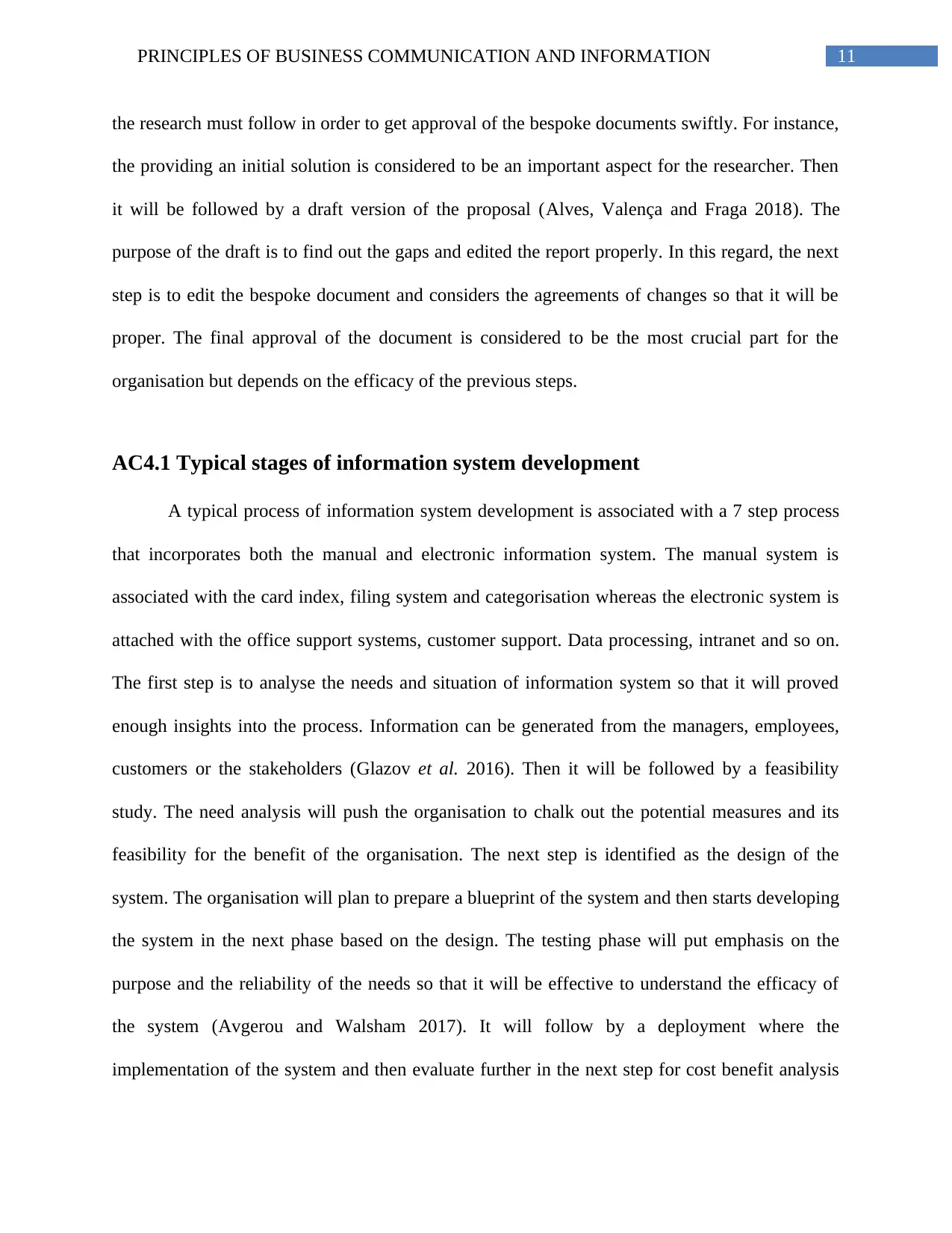
11PRINCIPLES OF BUSINESS COMMUNICATION AND INFORMATION
the research must follow in order to get approval of the bespoke documents swiftly. For instance,
the providing an initial solution is considered to be an important aspect for the researcher. Then
it will be followed by a draft version of the proposal (Alves, Valença and Fraga 2018). The
purpose of the draft is to find out the gaps and edited the report properly. In this regard, the next
step is to edit the bespoke document and considers the agreements of changes so that it will be
proper. The final approval of the document is considered to be the most crucial part for the
organisation but depends on the efficacy of the previous steps.
AC4.1 Typical stages of information system development
A typical process of information system development is associated with a 7 step process
that incorporates both the manual and electronic information system. The manual system is
associated with the card index, filing system and categorisation whereas the electronic system is
attached with the office support systems, customer support. Data processing, intranet and so on.
The first step is to analyse the needs and situation of information system so that it will proved
enough insights into the process. Information can be generated from the managers, employees,
customers or the stakeholders (Glazov et al. 2016). Then it will be followed by a feasibility
study. The need analysis will push the organisation to chalk out the potential measures and its
feasibility for the benefit of the organisation. The next step is identified as the design of the
system. The organisation will plan to prepare a blueprint of the system and then starts developing
the system in the next phase based on the design. The testing phase will put emphasis on the
purpose and the reliability of the needs so that it will be effective to understand the efficacy of
the system (Avgerou and Walsham 2017). It will follow by a deployment where the
implementation of the system and then evaluate further in the next step for cost benefit analysis
the research must follow in order to get approval of the bespoke documents swiftly. For instance,
the providing an initial solution is considered to be an important aspect for the researcher. Then
it will be followed by a draft version of the proposal (Alves, Valença and Fraga 2018). The
purpose of the draft is to find out the gaps and edited the report properly. In this regard, the next
step is to edit the bespoke document and considers the agreements of changes so that it will be
proper. The final approval of the document is considered to be the most crucial part for the
organisation but depends on the efficacy of the previous steps.
AC4.1 Typical stages of information system development
A typical process of information system development is associated with a 7 step process
that incorporates both the manual and electronic information system. The manual system is
associated with the card index, filing system and categorisation whereas the electronic system is
attached with the office support systems, customer support. Data processing, intranet and so on.
The first step is to analyse the needs and situation of information system so that it will proved
enough insights into the process. Information can be generated from the managers, employees,
customers or the stakeholders (Glazov et al. 2016). Then it will be followed by a feasibility
study. The need analysis will push the organisation to chalk out the potential measures and its
feasibility for the benefit of the organisation. The next step is identified as the design of the
system. The organisation will plan to prepare a blueprint of the system and then starts developing
the system in the next phase based on the design. The testing phase will put emphasis on the
purpose and the reliability of the needs so that it will be effective to understand the efficacy of
the system (Avgerou and Walsham 2017). It will follow by a deployment where the
implementation of the system and then evaluate further in the next step for cost benefit analysis
⊘ This is a preview!⊘
Do you want full access?
Subscribe today to unlock all pages.

Trusted by 1+ million students worldwide
1 out of 18
Related Documents
Your All-in-One AI-Powered Toolkit for Academic Success.
+13062052269
info@desklib.com
Available 24*7 on WhatsApp / Email
![[object Object]](/_next/static/media/star-bottom.7253800d.svg)
Unlock your academic potential
Copyright © 2020–2025 A2Z Services. All Rights Reserved. Developed and managed by ZUCOL.





